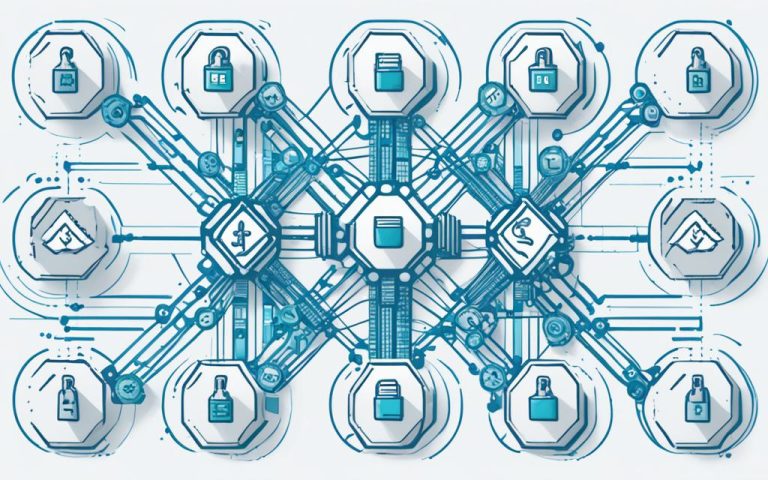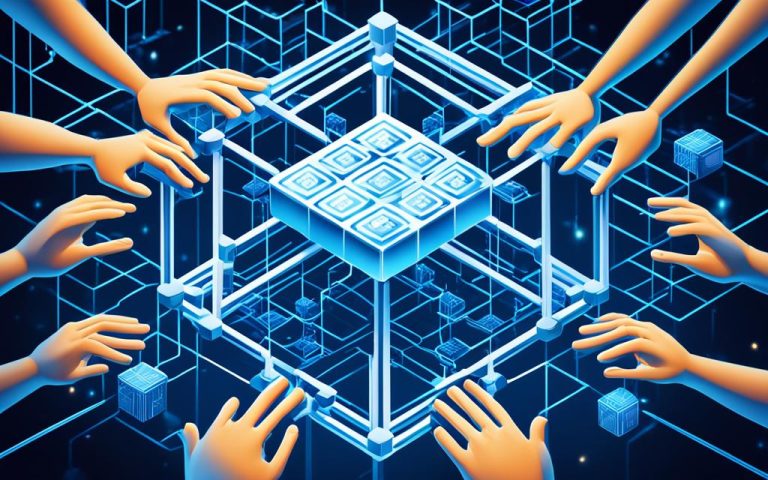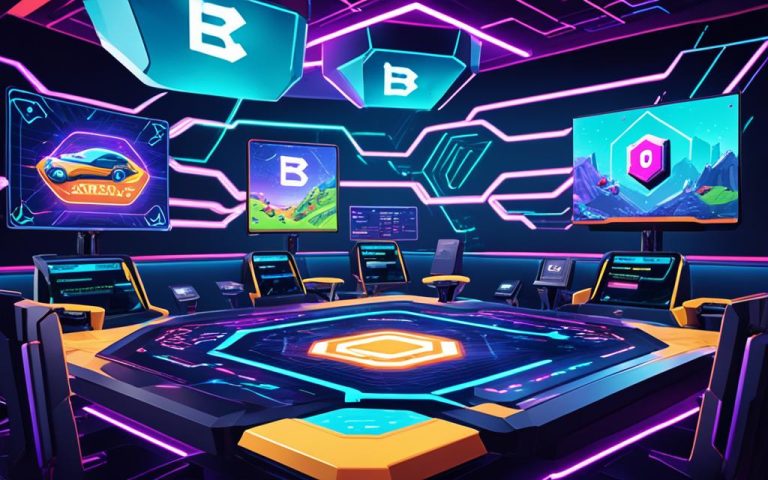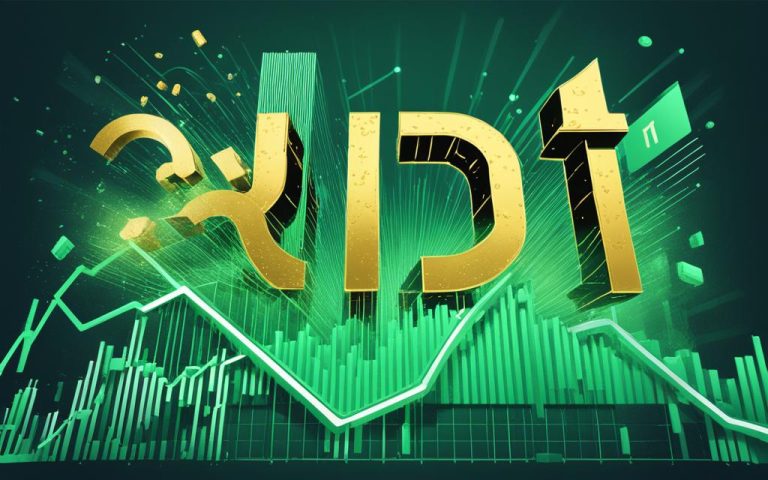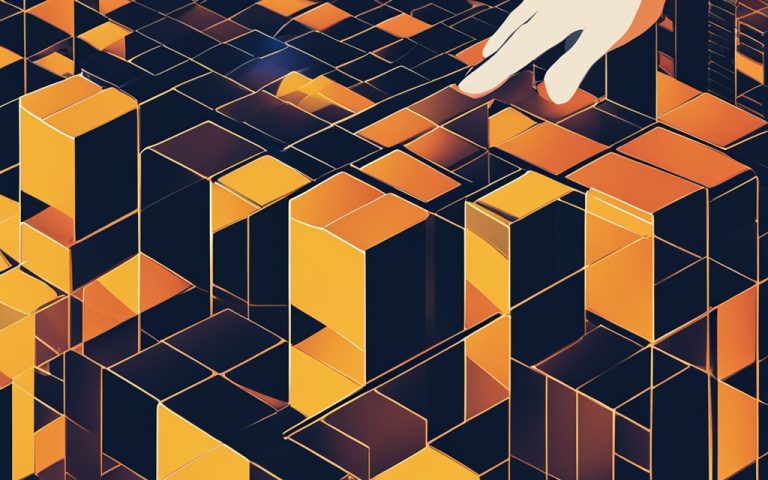Building a blockchain solution is thrilling. It can change various industries for the better. Whether you’re an entrepreneur, a developer, or a business owner, knowing how to build a blockchain is key. This guide will show you every step to create a secure decentralized network.
First, understand the problem you want to solve. Finding the right problem is your first step to a blockchain that brings real benefits. With a specific problem in mind, you can design your blockchain to offer the best solution.
Next, outline your business needs. Describe what your blockchain must do. Think about scalability, security, and transparency. This ensures your blockchain serves your users well.
Choosing the right consensus mechanism is vital. It’s how transactions are verified on the blockchain. Options like Proof of Work (PoW) or Proof of Stake (PoS) offer different benefits. Pick one that fits your goals and blockchain needs.
Then, select the best blockchain platform. Look at platforms like Ethereum, Hyperledger Fabric, and Corda. Compare their features, ease of use, and community support to find the best fit for your project.
Designing your blockchain nodes is crucial. Nodes verify transactions and keep the blockchain honest. Plan your nodes’ roles carefully for a secure network.
Plan your blockchain’s setup next. Think about block size, transaction speed, and how it connects. These choices affect how well your blockchain works. Good planning makes a strong blockchain.
Building APIs is key for a strong blockchain application. APIs let your blockchain talk to other systems. This makes for better integrations and interactions with apps.
A smooth user interface is important for success. It makes sure users can easily use your blockchain app. This encourages people to use it more.
Lastly, using an accelerator can improve your blockchain’s speed. Accelerators make transactions faster. This makes your app better for users.
Follow this guide to build your own blockchain, and embrace this game-changing tech. Let’s start this journey and make a blockchain that changes industries and helps users.
Step 1: Identify a Problem to Solve
The first step in creating a blockchain solution is to spot a real-world issue to tackle. Look closely at how things work in your business or industry. Find what doesn’t work well and needs fixing. This issue should be big enough to need a blockchain to fix it.
Blockchain solutions are designed to provide transparent, secure, and efficient solutions to complex problems.
Think about what good things blockchain can bring, like being decentralised, unchangeable, and more trustworthy. Ask if these good things help solve your problem and if blockchain is the best way to fix it.
Write out a problem statement that lists the issues you want to solve with blockchain. Make your goals and what you expect from your blockchain solution clear. This helps keep your project on track and focused.
The problem statement serves as a guiding document that helps direct your blockchain development efforts.
Now, decide if you need to change your current system to a blockchain or start fresh. Check how well you can add blockchain to what you already have. This step helps you see how big the project will be.
This evaluation will help you understand the scope and requirements for developing your blockchain solution.
Step 2: Draft Your Business Requirements
After finding the problem, it’s time to write your business requirements. This key step creates the base for your project’s success. It lists the specific needs and features your blockchain must have.
When writing business requirements, focus on your blockchain’s main goal. Think about what makes your project special and who it will help.
Consider the on-chain technologies needed, like smart contracts and secure transactions. These technologies make sure your transactions and data are safe.
Then, look at off-chain technologies. This includes user interfaces and external systems that help your blockchain work well with others. These technologies make using your blockchain easy and efficient.
Now, make a detailed product roadmap. This plan will show all the steps, when they’ll happen, and what you need to do them. It keeps you focused, making sure you build a successful blockchain.
Work with your team and talk to stakeholders to polish your business requirements and roadmap. This back-and-forth will bring in new ideas. It makes sure what you build fits your or your market’s needs.
Benefits of Drafting Business Requirements:
- Provides clarity and direction for the blockchain project
- Aligns stakeholders and team members towards a common goal
- Identifies necessary technologies and infrastructure
- Enables effective resource planning
- Facilitates communication and understanding among project stakeholders
Example Business Requirements:
| Business Requirement | Description |
|---|---|
| Secure and Transparent Transactions | The blockchain system must ensure the security and transparency of all transactions recorded on the network. |
| Scalability and Performance | The system needs to handle a high volume of transactions with minimal latency to meet the demands of a growing user base. |
| Interoperability | The blockchain should be compatible with existing systems and allow seamless integration and data exchange. |
| Privacy and Data Protection | User data should be securely stored and accessible only to authorized individuals while complying with applicable data protection regulations. |
By thoughtfully preparing your business requirements and including all necessary tech and operational parts, you lay the groundwork for a successful blockchain project. This ensures your organization’s needs are met and brings meaningful results.
Step 3: Identify a Consensus Mechanism
You’ve pinpointed the problem and what you need from blockchain. Now, let’s look at consensus mechanisms. These mechanisms are key for trust, security, and agreement in a decentralized network.
There are a few consensus mechanisms to choose from, each with its own benefits. Some popular ones are:
- Proof of Work (PoW): Participants solve puzzles to validate transactions. It’s secure but uses a lot of energy.
- Proof of Stake (PoS): Owners of coins help create blocks and validate transactions. It saves energy but might concentrate power.
- Byzantine Fault-Tolerant (BFT): This aims for consensus despite failings or attacks. It’s reliable but may face scaling issues.
Pick a consensus mechanism that meets your business needs, considering factors like scalability and energy use. The right choice builds trust and enables confident transactions in your network.
Choosing the right mechanism is foundational for a strong blockchain solution. Next, we’ll look at how to pick the best blockchain platform for your project.
Step 4: Choose the Best Blockchain Platform
Picking the right blockchain platform is vital for your project’s success. It impacts how well your project does. Think about what your business needs and wants to achieve.
You need to think about what issues you’re trying to fix using blockchain. Each platform has different strengths and features. Find one that fits what you need.
The way a platform reaches agreement, or its consensus mechanism, is key. It affects how transactions are checked and agreed upon. Look at how this mechanism affects your project’s security, growth, and efficiency.
Cost and the skills your team needs are also big factors. Look at all the fees and the technical know-how required. Make sure your team can handle the platform’s demands.
Doing your homework is key to finding the right blockchain platform. Think about its reputation, support from users, tools for developers, and how it grows. With good research, you can pick a platform that meets your business’s specific needs and leads to success.
Choosing the right platform means matching it with what your business aims to solve. This includes looking at how it handles agreements, its costs, and what your team can do. By picking a suitable platform, you help ensure your blockchain project does well.
Step 5: Design Your Blockchain Nodes
Designing your blockchain nodes is key to a great blockchain network. You have to think about several things. This includes what kind of blockchain, programming languages, how to deploy it, and what operating system it will run on.
Choosing the Right Blockchain Network
First off, decide if you want a permissioned or permissionless blockchain. A permissioned one only lets certain people in, giving you more control. A permissionless blockchain, however, is open to anyone, which supports openness and decentralization.
Think about what you need from your blockchain, like scalability, privacy, and how it’s governed. Choose the type of network that fits your goals and needs the best.
Selecting the Programming Languages
Then, you need to pick the right programming languages. This choice greatly affects your blockchain app’s efficiency and what it can do.
Most blockchain cores are made with C/C++, Go, Java, Rust, Haskell, and Ruby.
Look at what each programming language offers. For example, C/C++ is fast and offers detailed control, while Java is widely used and works on many platforms. Pick languages that give your project strength and are easy to work with.
Deployment Options and Operating System Compatibility
Next, figure out how to deploy your nodes and what operating systems they will work with.
You can put your nodes in the cloud, run them on your own hardware, or use both ways. The cloud is flexible, scalable, and affordable, but having your nodes on-site gives you more security and control. Think about what you need and pick the best way to deploy.
Also, make sure your blockchain works well with the operating system you choose. It should support the programming languages and tools you’re using.
Summary
In summary, to design great blockchain nodes, consider the type of network, programming languages, deployment, and OS compatibility. Careful design leads to a strong, efficient blockchain network that fits your requirements.
- The Developer’s Guide to Blockchain Development
- How to Build a Blockchain: Step-by-Step
- Create Your Own Blockchain
| Factors to Consider | |
|---|---|
| Type of Blockchain Network | Permissioned or Permissionless |
| Programming Languages | C/C++, Go, Java, Rust, Haskell, Ruby |
| Deployment Options | Cloud, On-Premises, Hybrid |
| Operating System Compatibility | Ubuntu, CentOS, Debian, Windows, Red Hat |
Step 6: Plan Your Blockchain Configuration
When you build a blockchain, planning the configuration is key for success. You should think about permissions, address formats, block signatures, and more. This helps you make a strong and efficient network.
Understanding Permissions
Permissions are vital in setting up a blockchain. They let you allow certain actions or roles in the network. By setting these permissions, you keep your blockchain secure and maintain its quality.
Configuring Address Formats
How participants communicate with the network depends on the address formats. Setting these formats right ensures smooth transactions in your blockchain ecosystem.
Implementing Block Signatures
Block signatures check if blocks in the blockchain are real and unchanged. Using strong block signature methods boosts your network’s security against attacks.
“Planning your blockchain configuration involves considering various elements such as permissions, address formats, block signatures, and more. Determine the parameters that need to be configured and plan ahead to ensure successful development.”
Planning these elements well helps you meet your project’s needs. It’s important to understand your project and get advice from field experts. This ensures your blockchain’s setup is the best it can be.
For more info on how to make a blockchain, check out these sites:
- Creating a Cryptocurrency – Zenledger
- Blockchain Application – Aloa
- Creating Your Own Blockchain Network –
Continue to the next step in building a blockchain: Step 8: Conclusion.
Conclusion
Creating a blockchain might seem tough, but this article has given you a full guide. By taking it step by step, you can make a blockchain that fits your needs. It’s all about tackling the process piece by piece and using the best approaches.
First, find out the problem you wish to solve. Next, lay out what you need from your business and pick the right consensus mechanism and blockchain platform. When you design your blockchain nodes and plan their setup carefully, your blockchain project will likely succeed.
This step-by-step guide arms you with what’s needed to create a secure, scalable blockchain. Dive into the world of blockchain innovation, and open up new opportunities for your business or project.
FAQ
What are the key steps involved in building a blockchain solution?
To build a blockchain solution, start by figuring out the problem you want to solve. Then, list what you need, choose how to agree on transactions, and pick a blockchain platform. Next, plan how the system will work, set it up, and make it run better.
How do I identify the problem I want to solve with a blockchain solution?
Think about what your business needs. See how blockchain can meet those needs. Write down the issues to tackle and check if blockchain can help.
What is the importance of drafting business requirements in building a blockchain solution?
Drafting business requirements shows what technologies you need for your project. It helps you make a clear plan and keep track of time and resources.
What is a consensus mechanism and why is it important for a blockchain solution?
A consensus mechanism helps everyone agree in a trustworthy way. It keeps the network safe and reliable. There are many types, like proof of work or stake, each with its pros and cons.
How do I choose the best blockchain platform for my solution?
Pick a blockchain platform by thinking about what problem you’re solving, what it costs, and what the tech needs are. Doing good research will help you find one that fits your project.
What is the significance of designing blockchain nodes?
When you design blockchain nodes, you decide if you need permission to join, pick programming languages, the kind of solution, and the operating system. Getting these choices right is key for a secure and fast blockchain.
What elements should I consider when planning my blockchain configuration?
For your blockchain setup, think about who can join, how to manage assets, swap things smoothly, handle keys, and use multi-signatures. Planning these things well helps your blockchain work right.
How can I build my own blockchain solution?
Follow the steps we talked about here to build your blockchain. Figure out your problem, set your goals, choose how to agree on things, pick a platform, design your network, get your setup right, and refine your application. With these steps, you can create a blockchain solution safely.














